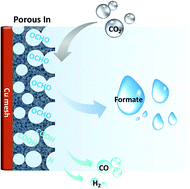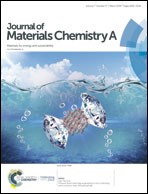3D hierarchical porous indium catalyst for highly efficient electroreduction of CO2†
Abstract
The electrochemical reduction of CO2 requires highly active, selective as well as stable electrocatalysts. Herein, we report a three-dimensional hierarchical porous indium catalyst for the electroreduction of CO2 to formate. In aqueous bicarbonate solution, the catalyst exhibits a high faradaic efficiency for formate (∼90%) in the potential range of −1.0 to −1.2 V (vs. reversible hydrogen electrode) and reaches an unprecedented formate production rate of 1.14 mmol cm−2 h−1 at −1.2 V. Additionally, the catalyst also displays a long-term stability (24 h). Density functional theory calculations reveal the catalytically selective nature of In for formate production. Independent of the crystal facet, In surfaces stabilise *OCHO, a key intermediate for the formate pathway, much more effectively than the *H (for the H2 pathway) and *COOH (for the CO pathway) intermediates. Experimental results demonstrate that the improved CO2 reduction selectivity on the porous In catalyst originates from the reduced evolution of H2, which is induced by the high local pH in the vicinity of the electrode. Furthermore, the porous In can also serve as a template to synthesise a porous Pd–In catalyst for tuning the selectivity of formate and CO, demonstrating its promising potential for CO2 electroreduction.



 Please wait while we load your content...
Please wait while we load your content...